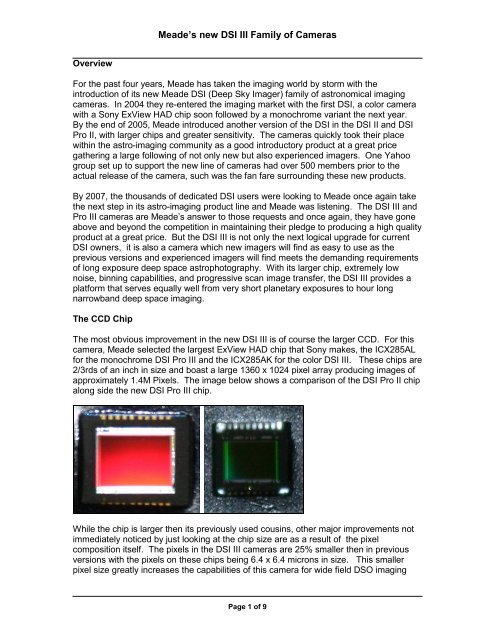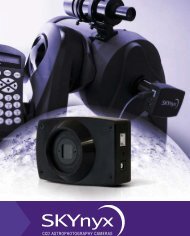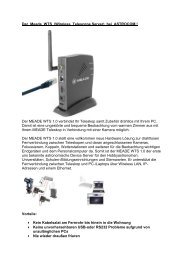You also want an ePaper? Increase the reach of your titles
YUMPU automatically turns print PDFs into web optimized ePapers that Google loves.
Overview<br />
<strong>Meade</strong>’s new <strong>DSI</strong> <strong>III</strong> Family of Cameras<br />
For the past four years, <strong>Meade</strong> has taken the imaging world by storm with the<br />
introduction of its new <strong>Meade</strong> <strong>DSI</strong> (Deep Sky Imager) family of astronomical imaging<br />
cameras. In 2004 they re-entered the imaging market with the first <strong>DSI</strong>, a color camera<br />
with a Sony ExView HAD chip soon followed by a monochrome variant the next year.<br />
By the end of 2005, <strong>Meade</strong> introduced another version of the <strong>DSI</strong> in the <strong>DSI</strong> II and <strong>DSI</strong><br />
<strong>Pro</strong> II, with larger chips and greater sensitivity. The cameras quickly took their place<br />
within the astro-imaging community as a good introductory product at a great price<br />
gathering a large following of not only new but also experienced imagers. One Yahoo<br />
group set up to support the new line of cameras had over 500 members prior to the<br />
actual release of the camera, such was the fan fare surrounding these new products.<br />
By 2007, the thousands of dedicated <strong>DSI</strong> users were looking to <strong>Meade</strong> once again take<br />
the next step in its astro-imaging product line and <strong>Meade</strong> was listening. The <strong>DSI</strong> <strong>III</strong> and<br />
<strong>Pro</strong> <strong>III</strong> cameras are <strong>Meade</strong>’s answer to those requests and once again, they have gone<br />
above and beyond the competition in maintaining their pledge to producing a high quality<br />
product at a great price. But the <strong>DSI</strong> <strong>III</strong> is not only the next logical upgrade for current<br />
<strong>DSI</strong> owners, it is also a camera which new imagers will find as easy to use as the<br />
previous versions and experienced imagers will find meets the demanding requirements<br />
of long exposure deep space astrophotography. With its larger chip, extremely low<br />
noise, binning capabilities, and progressive scan image transfer, the <strong>DSI</strong> <strong>III</strong> provides a<br />
platform that serves equally well from very short planetary exposures to hour long<br />
narrowband deep space imaging.<br />
The <strong>CCD</strong> Chip<br />
The most obvious improvement in the new <strong>DSI</strong> <strong>III</strong> is of course the larger <strong>CCD</strong>. For this<br />
camera, <strong>Meade</strong> selected the largest ExView HAD chip that Sony makes, the ICX285AL<br />
for the monochrome <strong>DSI</strong> <strong>Pro</strong> <strong>III</strong> and the ICX285AK for the color <strong>DSI</strong> <strong>III</strong>. These chips are<br />
2/3rds of an inch in size and boast a large 1360 x 1024 pixel array producing images of<br />
approximately 1.4M Pixels. The image below shows a comparison of the <strong>DSI</strong> <strong>Pro</strong> II chip<br />
along side the new <strong>DSI</strong> <strong>Pro</strong> <strong>III</strong> chip.<br />
While the chip is larger then its previously used cousins, other major improvements not<br />
immediately noticed by just looking at the chip size are as a result of the pixel<br />
composition itself. The pixels in the <strong>DSI</strong> <strong>III</strong> cameras are 25% smaller then in previous<br />
versions with the pixels on these chips being 6.4 x 6.4 microns in size. This smaller<br />
pixel size greatly increases the capabilities of this camera for wide field DSO imaging<br />
Page 1 of 9
<strong>Meade</strong>’s new <strong>DSI</strong> <strong>III</strong> Family of Cameras<br />
allowing the astro-imager to use shorter focal length scopes without undersampling. In<br />
fact, the optimum focal length for these chips for wide field imaging falls between 400<br />
and 800mm, or around 1.5 arcseconds per pixel, which also makes telescopes such as<br />
the <strong>Meade</strong> 80ED APO and the <strong>Meade</strong> 8” Schmidt-Newtonians a nearly perfect match for<br />
these cameras. Many astro-photographers using smaller chip cameras attempt to get<br />
very wide field images by reducing focal lengths below 400mm with the results often<br />
being bloated stars and a loss of image detail. The <strong>DSI</strong> <strong>III</strong>, with its 6.4 micron pixel size<br />
makes these wide field images possible without sacrificing image quality.<br />
As mentioned before, the chip size in the new <strong>DSI</strong> <strong>III</strong> cameras is quite a bit larger then<br />
the previous <strong>DSI</strong>’s with the new camera have a pixel array nearly twice the size of the<br />
<strong>DSI</strong> II and over twice the size of the original <strong>DSI</strong>. The image below shows how each of<br />
these cameras stack up against each other in terms of image size.<br />
Of course, along with a larger image size comes a larger FOV. It should be noted that<br />
while the number of pixels is roughly double that of the <strong>DSI</strong> II, the pixels are smaller and<br />
as such, the FOV is not quite double that of the <strong>DSI</strong> II. However, as can be seen in the<br />
image on the following page, the FOV provided by the new chip is significantly larger<br />
then that provided previously and puts many larger objects on the chip in a single image<br />
that required a mosaic with the previous cameras.<br />
Page 2 of 9
<strong>Meade</strong>’s new <strong>DSI</strong> <strong>III</strong> Family of Cameras<br />
These two images of M31 were taken with scopes at nearly the same focal length. As<br />
can be seen, the image on the left was taken with a <strong>DSI</strong> <strong>Pro</strong> II and required several<br />
hours to capture and process into a four frame mosaic. The image on the right was<br />
taken with the <strong>DSI</strong> <strong>Pro</strong> <strong>III</strong> and required less then 1 hour to capture with no processing<br />
needed to form a mosaic as with the previous image. This feature alone will greatly<br />
increase the capabilities of the <strong>DSI</strong> cameras and objects that astro-photographers can<br />
add to their list as possible targets.<br />
Low Noise<br />
Noise generally exhibits itself in two ways in a <strong>CCD</strong> camera. The first is thru heat noise<br />
or hot pixels that show up in images as a direct result of exposure time and the<br />
temperature of the chip. The second type of noise is the random electronic noise that<br />
shows up as pixels of various brightness’s throughout the image. Imagers have long<br />
known that in order to increase the signal to noise ratio, many images must be captured<br />
and stacked, or averaged, together and dark frames must be subtracted from each<br />
individual image prior to stacking. This can mean many long hours of imaging the same<br />
target to achieve this perfect signal to noise ratio.<br />
One of the greatest benefits to the use of these chips in the new <strong>DSI</strong> <strong>III</strong> cameras is the<br />
extremely low noise when capturing long exposure images and the incredibly low dark<br />
current that will be seen in the dark frames. For the astro-photographer, this translates<br />
directly into fewer images required to gain the needed signal to noise ratio. Imagers that<br />
have used previous versions of the <strong>DSI</strong> or other cameras will notice a marked<br />
improvement in the signal to noise ratio and the ability to capture images in a much<br />
shorter time period then previously required.<br />
Page 3 of 9
<strong>Meade</strong>’s new <strong>DSI</strong> <strong>III</strong> Family of Cameras<br />
The image below shows the extremely low dark current of these chips. This image is a<br />
20 minute dark frame captured at 21.5 degrees Celsius. As can be seen, the number of<br />
hot pixels evident in the image is very low and the image must be highly stretched to see<br />
many of them at all.<br />
Due to the very low dark current of these cameras, <strong>Meade</strong> has been able to continue<br />
their tried and true approach to managing dark frames without the need for active<br />
cooling. In fact, since these cameras exhibit such a low count of hot pixels, users will<br />
find that they are able to utilize dark frames over a greater period of time and that they<br />
are able to take less dark frames for a given temperature allowing them to spend less<br />
time taking darks and more time capturing images. In tests performed at various<br />
temperatures on the new <strong>DSI</strong> <strong>Pro</strong> <strong>III</strong>, the author has found that for images of less then 2<br />
minutes, it is quite possible to capture reasonably good images without the use of dark<br />
frames by simply increasing the number of images captured and averaging them<br />
together using a sigma clip combine methodology.<br />
Of course, the real proof of the low noise characteristics of these cameras is in the<br />
images themselves. The image shown on the following page shows a single 3 minute<br />
exposure of M27 on the left (not stacked) and the resulting color image, on the right,<br />
created by taking L,R,G, and B filtered images. The low noise level and high contrast is<br />
easily evident in this image and is carried thru to the final image resulting in a highly<br />
detailed, low noise image.<br />
Page 4 of 9
<strong>Meade</strong>’s new <strong>DSI</strong> <strong>III</strong> Family of Cameras<br />
Another obvious benefit of such a low noise chip is its increased suitability to very long<br />
exposures as well. Exposures of 10 to 30 minutes are well within the capabilities of<br />
these cameras and when combined with their vast sensitivity across the light spectrum,<br />
they will open the door to greater use of both conventional and narrow band imaging.<br />
This image of a portion of the North American nebula was captured using Ha, SII, and<br />
O<strong>III</strong> filters and 10 minute exposures over a period of 3 hours.<br />
Page 5 of 9
<strong>Pro</strong>gressive Scan vs Interlaced<br />
<strong>Meade</strong>’s new <strong>DSI</strong> <strong>III</strong> Family of Cameras<br />
Another major improvement in the use of these chips for the <strong>DSI</strong> <strong>III</strong> cameras is the move<br />
form interlaced capture and download to a progressive scan download. In previous<br />
version of the cameras, the images captured by the chip were read off in odd and even<br />
lines, then combined back together to get the full image. For long exposures over a few<br />
seconds this was never an issue but for shorter exposures of less then a second, the<br />
lines were easily visible and restricted the camera from being very usable for planetary<br />
or lunar imaging.<br />
The new <strong>DSI</strong>’s now utilize a progressive scan approach to downloading the images<br />
meaning that the image is read off of the chip in larger chunks and as such does not<br />
exhibit the lines seen in images before. While this has a definite benefit in limiting noise<br />
in the longer exposures, it also has the added benefit of allowing imagers to now use<br />
their <strong>DSI</strong> <strong>III</strong> cameras in a dual role as both a DSO and Planetary imager.<br />
The image above was taken at exposures of less then a second an only 30 images were<br />
combined to utilizing the built in stacking routines of the Envisage software. Due to the<br />
cameras new smaller pixels and the progressive scan technology, it is now possible<br />
have an “All in one” camera that serves equally well on long and very short exposures.<br />
Page 6 of 9
<strong>Meade</strong>’s new <strong>DSI</strong> <strong>III</strong> Family of Cameras<br />
To put this to the ultimate test, I decided to try something I had never been able to do<br />
before and that was to take an image of the sun. For this I used the <strong>DSI</strong> <strong>Pro</strong> <strong>III</strong> Camera<br />
thru a PST solar scope and a <strong>Meade</strong> 3x Series 5000 barlow. The images ranged from 3<br />
hundredths to 1/3 rd of a second and again, I used the built in Envisage align and stack<br />
capabilities to capture an image of solar flares on the sun. The image below shows the<br />
results of that test and speak to not only what one could do with no experience but<br />
shows what might be done even better by someone with solar imaging experience.<br />
While I discovered that solar imaging poses many challenges that you might not find in<br />
other forms of astronomical imaging, the <strong>DSI</strong> <strong>III</strong> cameras are more then suited to the<br />
task of providing the imager with a platform that is highly capable of capturing these<br />
difficult images.<br />
Page 7 of 9
Binning<br />
<strong>Meade</strong>’s new <strong>DSI</strong> <strong>III</strong> Family of Cameras<br />
On Chip Binning is the ability of the chip produce an image that is half the size of the<br />
normal output by combining every other pixel together to produce a brighter image at a<br />
shorter exposure then would be possible at full output image size. This comes in very<br />
handy when doing RGB imaging and can become very important when doing long<br />
exposure narrow band imaging. By allowing the imager to take images in half the time<br />
but at the same brightness of a full frame image, the photographer is able to concentrate<br />
more time on the Luminance portion of an image taken at full frame size, and less time<br />
capturing the color channels that will go behind the luminance in the final image.<br />
Binning has been one of the more requested features of the previous <strong>DSI</strong> cameras and<br />
for the first time since the introduction of the <strong>DSI</strong>, <strong>Meade</strong> has provided binning to their<br />
users. To demonstrate how well this works, the image below shows a full frame<br />
luminance image on the left and a binned color channel image on the right.<br />
The image on the left is a stack of 3 minute images captured at the camera’s normal full<br />
frame size and the image on the right shows the red channel captured in a 2x2 binned<br />
mode at 1 minute and 30 seconds, half the exposure time of the full frame. As can be<br />
seen, the red channel image is equally as bright as the full frame image meaning that<br />
the imager is able to capture all of their color data in half the time and still get the<br />
excellent results they have come to expect form these cameras.<br />
Page 8 of 9
Conclusions<br />
<strong>Meade</strong>’s new <strong>DSI</strong> <strong>III</strong> Family of Cameras<br />
In this article, I have touched on many of the new and important enhancements that<br />
have been incorporated into the new <strong>DSI</strong> <strong>III</strong> and <strong>DSI</strong> <strong>Pro</strong> <strong>III</strong> cameras. As with previous<br />
versions, <strong>Meade</strong> has invested a great deal of time, energy, and testing into these<br />
cameras to ensure that the final camera is not only a great product at a great price, but<br />
also that they continue a tradition of quality and ever increasing capabilities for which the<br />
<strong>DSI</strong> family of cameras have become known. With the introduction of the <strong>DSI</strong> <strong>III</strong><br />
cameras, <strong>Meade</strong> is once again set to take the imaging world by storm and cement thier<br />
place at the table as a premier provider of high quality imaging products.<br />
At less then half the price of their competitor’s cameras, <strong>Meade</strong> has taken astronomical<br />
imaging to the next level and made it possible for many new and experienced imagers to<br />
participate in a world of previously reserved for purchasers of high priced cameras.<br />
Whether your goals are casual DSO imaging, very long exposure narrow band imaging,<br />
or even planetary, lunar, or solar imaging, the <strong>DSI</strong> <strong>III</strong> cameras are the single solution that<br />
will meet the needs of new and experienced imagers for many years to come.<br />
Stephen P. Hamilton<br />
King George Observatory<br />
38° 21' 26" , -77° 03' 04"<br />
Page 9 of 9





